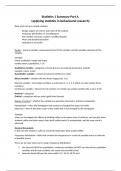Summary
Summary Part A Statistics 1 (Applying Statistics in Behavioural Research)
- Course
- Institution
- Book
This document contains the summary of part A of the statistics 1 course of B1 psychology. It was written in 2023 and based on the book Applying Statistics in Behavioural Research by Jules L. Ellis.
[Show more]




